Spyderco Smock is premium compression lock knife in collaboration between Spyderco knives and Kevin Smock, a visionary custom knife designer who is known for innovative, durable and inspirational knife designs.
Spyderco Smock is a folding knife with Kevin Smock’s custom SK23 design. Hence, Spyderco Smock has been launched 3-4 years from now but we are able to write its review now.
Although everyone has a different viewpoint regarding the Smock, we will be discussing both the pros and cons of the knife, and provide an objective view of the product.

The knife features a sleek handle, modified blade, stainless steel and a unique bottom compression lock. Another feature of the knife is its flipper tab that blends seamlessly with the handle and the overall profile, making it look attractive.
Although it is a premium quality production folder knife, it costs lesser than Spyderco knives’ other high-end pocket knives. On the official Spyderco website, it is priced at $304, and is out of stock.
However, you can find the Spyderco Smock knife in about $212.8 from its retailers and also get 2 free gift items as well apart from free shipping.
Spyderco Smock Prices |
||
|---|---|---|
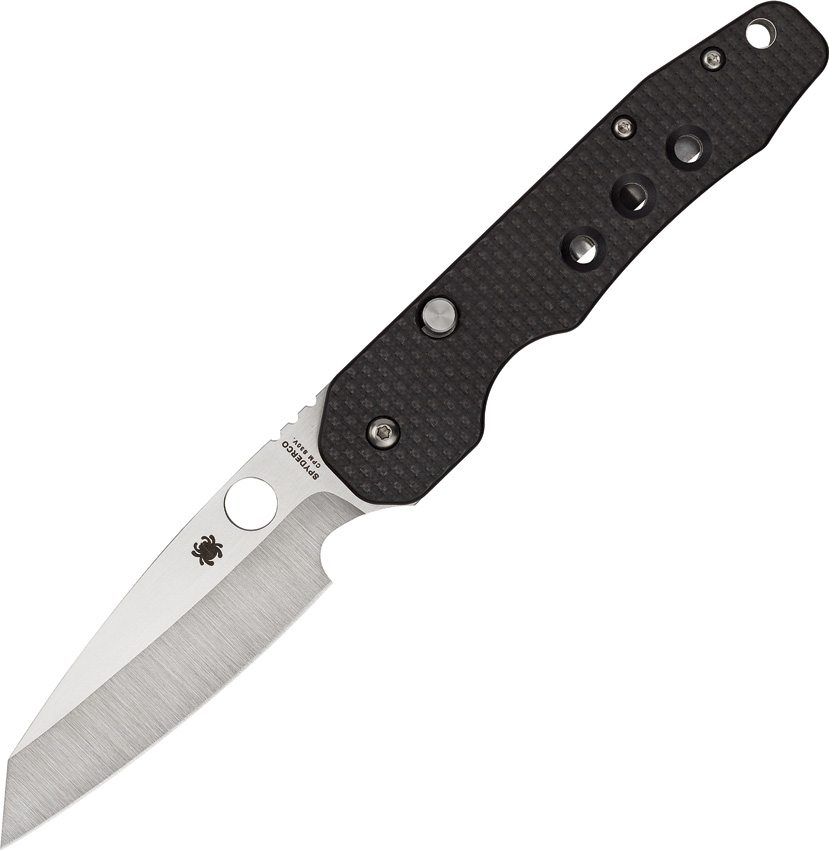 |
 |
Check Price at Blade HQ |
 |
Check Price at Chicago Knife Works | |
Key Specifications of Spyderco Smock C240CFP
Spyderco Smock Review
Spyderco Smock is a mid-tier folding knife made in Taiwan with EDC cutting capabilities in the pocket. The blade is precision machined with CPM S30V stainless steel, which is quite a popular blade type used in many good Spyderco knives.
The trademark round thumb opening hole is also unique to Spyderco knives with flipper opener. The ball-bearing pivot washers support this flipper action with a separate detent mechanism from the knife’s lock.
The handle includes stainless steel liners that hold the blade in place. It also supports the smooth opening and closing, covered by the carbon fiber/G10 laminate scales and an open-backed construction, making it lightweight and easy to carry. The reversible tip-up pocket clip coupled with ambidextrous carry also makes it easy to hang on to the pocket.
Unboxing and First Impressions of Spyderco Smock
From the first moment I saw Spyderco Smock, I knew I had to have it. I first tested it before purchasing, and the first time I flipped it open and close, I was hooked! Therefore, I placed my order.
It came in the same standard box as all the Spyderco knives do. The first thing I noticed was its new compression lock with a button. It makes the opening and closing so smooth and easy, and opens in one swift motion. Plus, the curve on the opposite side of the thumb hole makes it really easy to hold it with a tight grip and carry out any task.

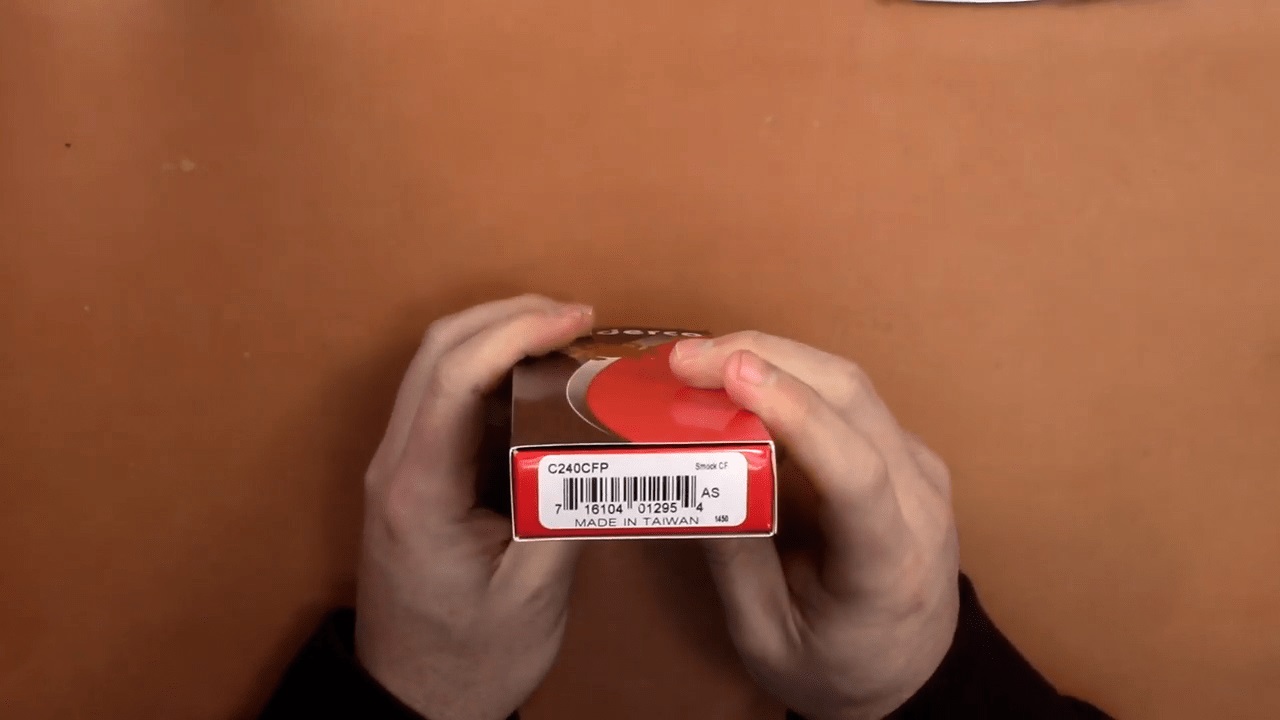
The Spyderco hole however, was smaller compared to other Spyderco knives like Spyderco Kapara, Paramilitary 2. It was mostly because of the button-operated compression lock, but at the same time makes it easier to open manually with one thumb, index finger, or even with middle finger!

The G10/carbon fiber laminate handle is another thing I really liked. It offers a much better grip than, say, the Kapara. Its texture is less slippery than other handle materials on other knives of Spyderco that I have experienced, so it’s definitely a win! However, some people have found it more powdery and slippery, and prefer the simple carbon fiber laminate handle.
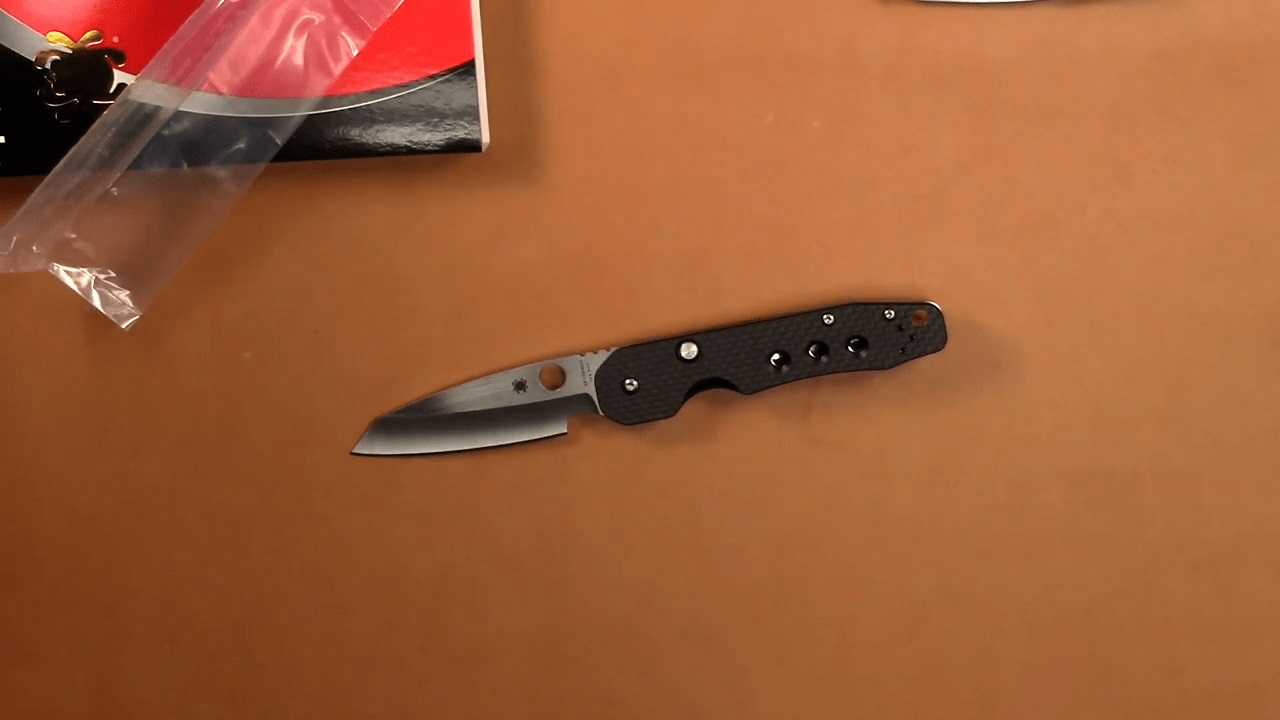
The blade is also held nice and tight with solid liners. It stays in place once opened for swift tasks. However, once you flick it in a direction indicating the closing action, it quickly picks up on it and goes in the closing mode. This knife really is made for the hand, whether you are right-handed or left. If you are left-handed, then you may have to use your index finger to press the button. Else, you can also flip your thumb over to the button for a slightly dramatic opening action. Closing is just as simple as done with the right hand.
I also liked the S30V blade as it seemed sharp enough with its hollow grind. The hollow grind is something new to me, and with closer examination revealed the vertical blade shape along the body and horizontal blade shape by the edge. The sheepsfoot blade was an excellent addition to the knife.
I conducted an initial test by slicing paper. It was such a smooth and relaxing action that I could not believe it.
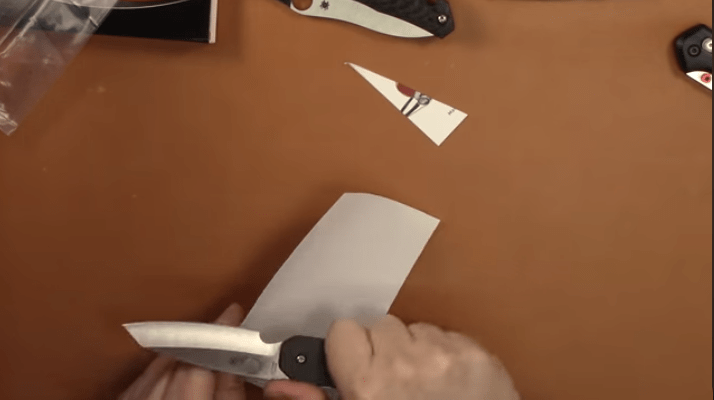

The pocket clip however, was not as good as compared to the Spyderco Kapara, or other clips. The wire clip holds well in the pocket or wherever you hang it. The silver clip has the chance of slipping off if you hang it loosely.
Moreover, it is not exactly rust-proof, and can break easily. However, the lanyard holes are not the worst. It is easier for people with arthritis or other hand difficulties to pull out of the pocket.

The Blade of Spyderco Smock
The Smock’s blade shape is sheepsfoot blade as some people may call it Wharncliffe blade. The sheepsfoot blade’s edge and spine remain parallel with a dramatic curvature towards the edge. It has a large area beneath the thumb hole to grip the knife for carrying out delicate tasks. The jimping however, is a bit sharp but not unsafe. It can easily carry EDC (Every Day Carry) tasks.
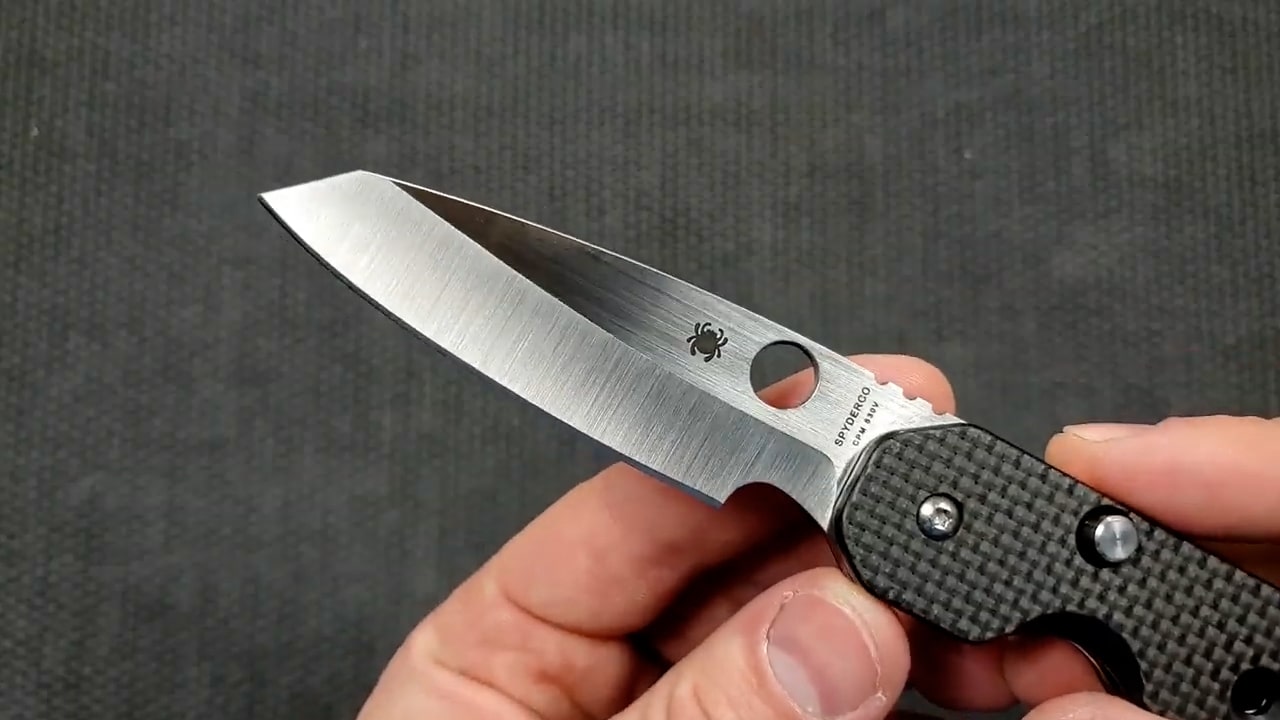

The Smock has a hollow grind, which is great because it gives the knife its thin geometry form behind the edge. It also has the perfect blade stock thickness, which is not too thin or thick. The other variants of the Smock also have this feature, making it a coveted knife choice.
The S30V blade steel with a reverse tanto makes it a great EDC slicer and cutter. Other knives may exhibit the same slicing and dicing qualities. However, the Smock carries day-to-day tasks better without tactical uses and prying capabilities.
The grind lines on the knife are new and appealing to the eyes. The vertical lines towards the edge of the blade seem raw, giving the impression of a sharp knife edge. The horizontal lines towards the spine on the flat portion are lightly stonewashed, which is great.

The Gayle Bradley and Gayle Bradley 2 by Spyderco, also made in Taiwan, has the same two-toned grind style. So we have some prior experience with this blade, and it offers great aesthetic to the knife.
The jimping however, is not the best on Smock. There are less than a few jimping lines on the blade’s spine without good finishing. Secondly, the notch cut at the blade’s base looked appealing at first. But upon closer examination, it reveals that we cannot use it as a forward finger choil because it is sharp to touch. If it could only be made 1/8” bigger and blunt, it would allow more control precision cutting. It is very much possible, since Kevin Smock uses the SK23 for forward usable choil.
However, if we look at it the other way round, you can use the notch cut more creatively. If only you could hold the knife from the back, it can make unique cuts.


The holes on the scales of the knife shows exactly where the blade is placed when the knife is closed. The standard hourglass pocket clip and the lanyard hole are easy to maintain.
On the other hand, the handle can be perceived as narrow by people who require heavier or more frequent tasks. The jimping also has mixed reviews. Some say it cuts without chamfering, and bites into the thumb.
Moreover, it is also criticized for G10 laminate over the carbon fiber. The carbon fiber alone could have made the handle stronger, albeit with a slightly higher composition than 1/6-1/8” of it. Some people may not even notice it, but knife enthusiasts might, therefore making it worth mentioning.
The handle texture however, is smooth with peel-ply style found on most of Spyderco models manufactured in USA. At the same time, it is lightweight with light texturing.
The Handle and Ergonomics of Spyderco Smock
Smock’s handle and its subsequent ergonomics has mixed reactions. While some love it, others find it slippery. It also depends on your hand size, shape, difficulties, or if you are right or left handed.
However, I feel like Spyderco stands true to its motto of ‘made for the hand, not for the eye.’ The 12 cm long handle fits perfectly in my hand, and the curvatures allow a firm grip via the fingers.
The handle scales ae durable and stylish looking, while providing good traction


The holes on the scales of the knife shows exactly where the blade is placed when the knife is closed. The standard hourglass pocket clip and the lanyard hole are easy to maintain.
On the other hand, the handle can be perceived as narrow by people who require heavier or more frequent tasks. The jimping also has mixed reviews. Some say it cuts without chamfering, and bites into the thumb.
Moreover, it is also criticized for G10 laminate over the carbon fiber. The carbon fiber alone could have made the handle stronger, albeit with a slightly higher composition than 1/6-1/8” of it. Some people may not even notice it, but knife enthusiasts might, therefore making it worth mentioning.
The handle texture however, is smooth with peel-ply style found on most of Spyderco models manufactured in USA. At the same time, it is lightweight with light texturing.
Deployment and Lockup of Spyderco Smock
There are multiple ways to deploy the Smock. You can use the button or flip it open manually with any of your fingers to flip it open in one swift motion. The Kizer theta also has a similar flipper action, but instead of the button it features a flip-clip.
The detent on the Smock however, is tight enough for smooth deployment and holding the blade in place. It is also one of the best fidget-friendly flippers as found by most of its users. In fact, in some cases, that was the first impression of the knife and what made it appealing.
The top flipper leaves enough room at the bottom of the blade and top of the handle. At the same time, it gets out of the way when the blade is open.
I especially liked the fact that Spyderco still made the thumb hole big enough to open it manually if someone is not used to the button lock. It makes an effective operation for people with different sorts of hands.
And although I am comfortable with phosphorus bronze washers, flippers are more frictionless. But they can also be easily scratched and attract dirt and debris, thereby requiring constant cleaning.
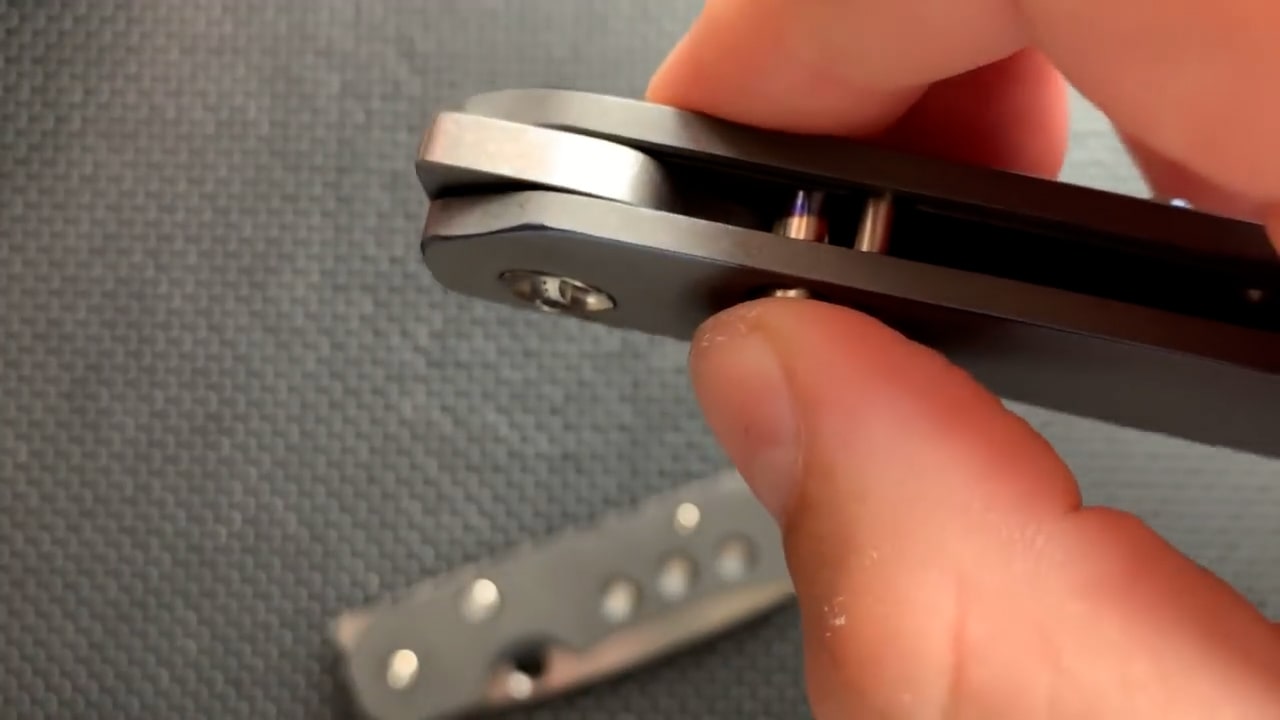
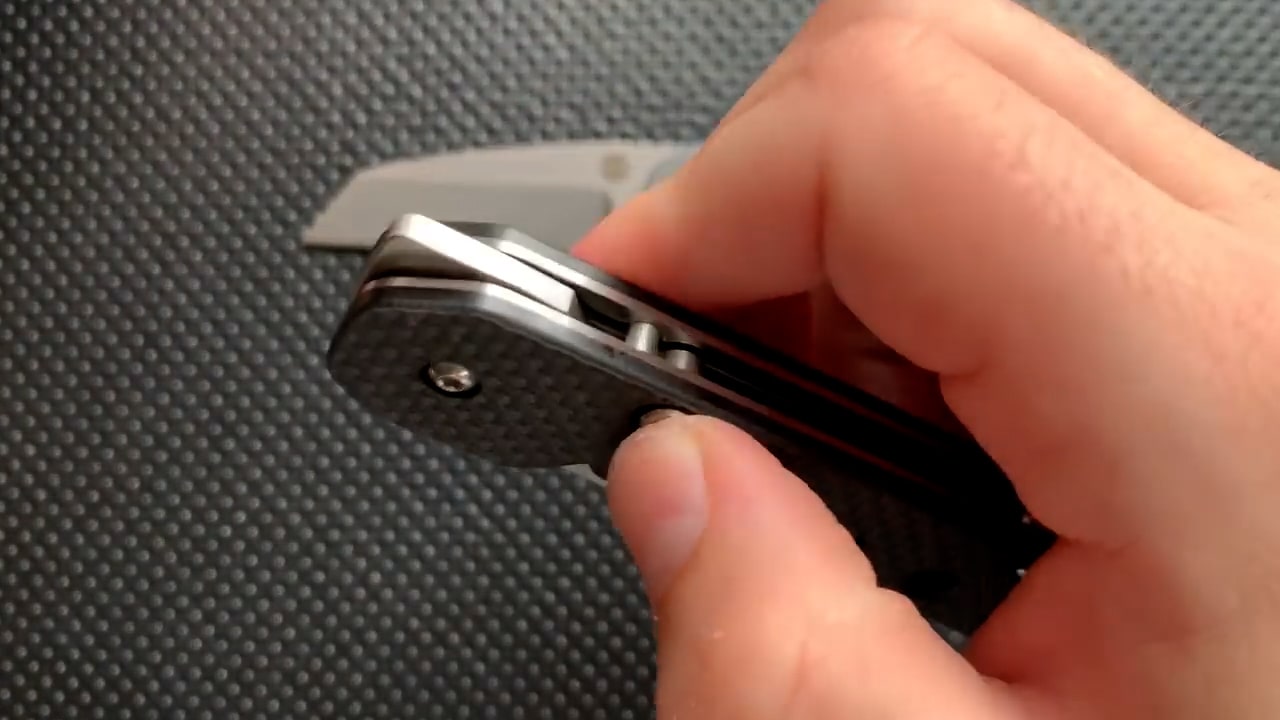
Moreover, the button compression lock is different from a simple button-action lock. A standard button lock uses the plunge style lock and the deployment method, whereas Smock also has manual action. It also has left-handed compression button on its side that can be seen protruding from the handle.
And the button is not just for opening, but closing the knife as well. Hence, it can be treated as a fidget flipper fun, effective in reducing stress and enhancing concentration when someone is deep in thought. And the best part is that it allows the fingers to get out of the way when closing the knife, making it safe.

Experience with Spyderco Smock
A good Spyderco Smock review would be incomplete without field testing and reporting the findings. Now that we have discussed the knife’s features, let us put it to test. I started by cutting cardboard boxes, and it sliced right through it with a straight line.
I tested the edge retention while cutting the cardboard boxes, and it held its own. However, I did notice that the hollow grind is rather short when I tried cutting multiple layers of the cardboard in one swift motion.
Although the blade thickness was fine, the overall weight and features of the knife seemed a bit heavy for it. I noticed this when cutting through thicker stacks of cardboard.


Moreover, the choil seemed a bit uncomfortable during the action. It got in the way and felt sharp than it was supposed to. I also found my finger stuck up in the finger choil with the belly of the blade curved tip cutting through the cardboard. Hence, I found myself repositioning my finger again and again, which was uncomfortable.
Maybe the Smock or even a pocket knife is not the best tool to cut cardboard boxes, Smock did well. A razor on the other hand, might perform better.
The Smock was also easy to sharpen. I had this expectation from knives made in Taiwan or Japan factory. The S30V is one of my favorite steel blades that can perform EDC actions.
I continued the action for quite some time, and the knife retained its edge sharpness. However, the handle required cleaning in between, which I wasn’t very thrilled with.
Comparison
Spyderco Smock vs. Kapara

Kapara is very similar to Smock, as compared before. However, some of the differences between the two are in terms of grind, handle, clip, price, and size. The Kapara is slightly bigger than Smock by just 0.35” in overall size. Similarly, its closed length, blade length and edge length are also slightly different.
Moreover, the Kapara has a full-flat grind as opposed to a hollow grind on Smock. The hollow grind is unique to the knife’s design. And although it may require some getting used to, I’d prefer the hollow grind over full-flat grind.
The pocket clip is also the same on both with ambidextrous clip. However, the Kapara has a thinner clip than Smock, and preferred over the Smock clip.
There is also a price difference between the two. Kapara is more expensive than Smock.
The ergonomics on Kapara are also better than Smock because Kapara only has carbon fiber handle, whereas Smock has a G10 laminate over the carbon fiber. Many people questioned the logic of adding the G10 laminate over the carbon fiber. They prefer the carbon fiber, hence preferring Kapara over Smock.
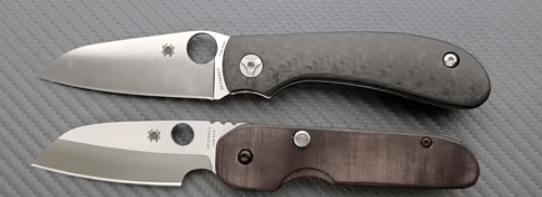
The preference between the two knives depends upon their utility and affordability. If you are a regular knife user and require more EDC knives, then Kapara may be a good choice. However, if you do not want to pay a premium price for slightly better functions, then Smock is also good enough. It can easily carry EDC tasks, and good for carrying with you for light cutting tasks.

Spyderco Smock Prices |
||
|---|---|---|
 |
 |
Check Price at Blade HQ |
 |
Check Price at Chicago Knife Works | |
Spyderco Smock vs. Smock SK23

The comparison between Smock and SK23 is obvious because it’s simply the other variant of Smock. However, while the Smock is custom knife, SK23 is a production knife. The Smock was based off of the SK23, deriving inspiration from it.
However, the SK23 is pricier than Smock in the $800 range! Now that is a huge difference compared to Smock’s $212.8. The overall profile, the button-lock mechanism and the handle are the same. However, the custom Smock knife has a fuller finger choil, rounded spine, and does not have a secondary detent unlike the SK23. This detent prevents the knife from flipping open when we press the button on the compression lock, as opposed to the custom Smock that immediately flips open.
It also has multiple steel options and finishing upgrades.



The stock thickness on the two knives is also very different. The original Smock’s has a thicker stock than the SK23. However, that’s not an issue since the grind is more important than the stock. When it comes to blade sharpness, the original Smock tends to hold the edge retention better than the SK23. At the same time, the SK23 is better at performing heavier tasks than the original Smock.

When it comes down to it, I would prefer the original Smock as opposed to the production SK23. A major reason for this is the price. However, if you love spending on knives and have to have the SK23, then you are welcome to. However, both the knives perform nearly similar functions, even though heavy knife users may prefer SK23.
Pros & Cons of Spyderco Smock
PRO’s
Con’s
Conclusion
Spyderco Smock review is important because it falls in the category of custom knives with a collaboration with a custom knife maker. It is not the first time that Spyderco has collaborated with a custom knife manufacturer.
Smock is a custom folding knife by Kevin Smock. He paid special attention to the handle by laminating the carbon fiber with G10 scales. However, it did not receive much appreciation from the customers, who preferred only the carbon fiber handle. When testing, the finger choil got in the way and is sharper than it was supposed to be.
It features a hollow grind with a sharper tip for precision cuts, which I really liked. Another notable thing about the knife is its unique button compression lock. It was well-liked by the knife enthusiast community, since it can be opened in multiple ways, and with both left and right hand.
